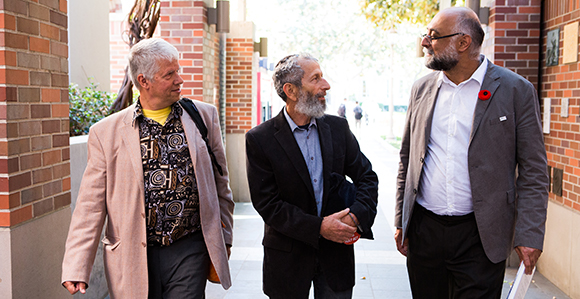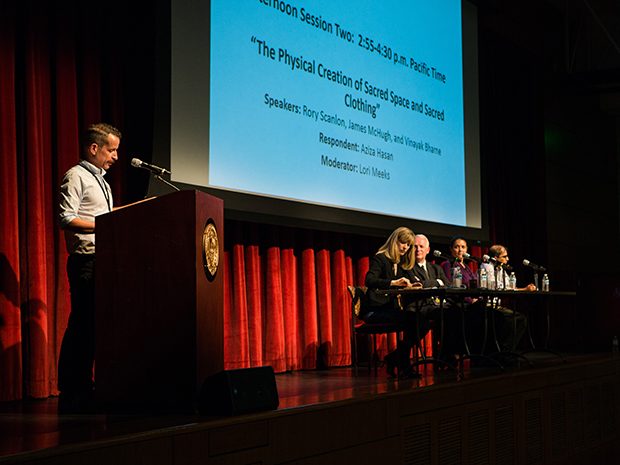“Sacred Space, Sacred Thread” Global Conference at USC
Contributed By Jan Hemming, Los Angeles Public Affairs Office

Catholic scholar Pim Valkenberg from Catholic University, left; Rabbi Reuven Firestone, of the Hebrew Union College, and Amir Hussain, professor of theological studies at Loyola Marymount College, at the “Sacred Space, Sacred Thread” conference held at USC, November 3–4, 2016.
Article Highlights
- How is sacredness defined in today’s world?
- Scholars, theologians, and religious leaders gathered to discuss sacredness.
- Among the other topics discussed was sacred clothing.
LOS ANGELES, CALIFORNIA
Amid today’s cultural clashes and an ever-shifting secular society, do sacred spaces still have purpose and meaning, and what defines a sacred space?
Scholars, theologians, and religious leaders from across the country and overseas, representing more than a dozen faith traditions, explored these topics and many others, including current attitudes toward sacred clothing, at the “Sacred Space, Sacred Thread” global conference at the University of Southern California November 3–4, sponsored by the John A. Widtsoe Foundation, the Academy for Temple Studies, and USC’s Office of Religious Life.
Sacred spaces
Helen Williams, dean of the Graduate School of Education and Psychology at Pepperdine University and an ordained pastor in the American Methodist Episcopal Church, said, “Sacred spaces must be open to the mundane. … God blew into man the breath of life. That means the sacred is within us. We need to share that sacredness with everyone.”
There is much today that we can learn about sacred spaces from the temple sanctuary that Jews revered while they wandered in the wilderness for 40 years, according to Roy Gane, professor at the Seventh-day Adventist Theological Seminary at Andrews University. “The Israelite sanctuary is long gone, but the sovereign, immanent, transcendent deity whose attributes it reflected are still with us … and are more accessible than ever through Christ.”
Rabbi Reuven Firestone, professor at Hebrew Union College and an affiliated faculty member at USC, said that for Jews, the sacredness of the temple in modern times has been transferred into Jewish homes through ritual observances like the Passover or Sukkot. Jews don’t have special places set aside for prayer, nor do they have special architecture, in Rabbi Firestone’s opinion.
Sacred clothing
Sacred clothing was addressed most frequently by Muslim and LDS presenters. Edina Lekovic, a consultant for the Muslim Public Affairs Council and formerly a national media spokeswoman for Muslims, said the outer garments that Muslims wear like the hijab—a scarf covering a woman’s head and hair—denote not only modesty but also a personal devotion to God and a witness of the Muslim faith. While the hijab has subjected Muslim women to violence and hate crimes, “when a woman wears a hijab she is showing courage.”
Mormons wear sacred vestments next to their body, explained Patrick Mason, Howard W. Hunter Chair of Mormon Studies and interim dean at Claremont Graduate University, representing a divine injunction that “we are literally clothed with divinity. … These garments give us daily reminders that our bodies are the most sacred thing that God has given us, so we should not only respect our bodies, but the bodies of others.”
Larry Eastland, chairman and president of the Widtsoe Foundation, opened the conference in the main ballroom of the Ronald Tutor Campus Center at USC, declaring that while our faiths might be different, “we are brothers and sisters, not adversaries.”
In her keynote address, the “Making and Meaning of the Coloured Fabrics of the Temple,” Margaret Barker, an ordained Methodist minister, British theologian, biblical scholar, and author, said knowledge of the veil in the original Jewish temple has been removed from religious written traditions because of purges imposed by King Josiah, but added “he could not remove them from the memory of his people.”
There were only two who wrote about the rich meaning of the veil, Philo, a diaspora Jew in Egypt who was a contemporary of Jesus, and the historian Josephus. They “broke the rules and revealed the meaning of the colors” which were red (fire), purple (water), blue (air), and white (representing both earth and the garments of angels). The veil separated man—represented by the high priest—from the presence of God in the Holy of Holies and carried deep symbolism: creation, wisdom, and knowledge. Before entering the Holy of Holies, the priest was anointed with oil—“which means his mind had been illuminated with a bright light.” Upon entering the Holy of Holies, this anointed priest was not merely a man, but became a divine being, the child of incorruptible parents, “his Father being God,” said the Rev. Barker.
Sacred places
Pim Valkenberg, a professor of religion at Catholic University in Washington, D.C., said Catholics regard cathedrals and places of worship with great reverence because during the sacrament the priest is “consecrating the body and blood of Christ.” For Catholics, Christ is not a memory but constantly present in communities and places where believers gather.
Varun Soni, dean of religious life at USC and a Hindu, encounters many students who struggle with the “dark side” to find meaning and purpose in their lives. “I want my students to live these questions; to find authenticity. It is important for people who are not religious to identify what is sacred to them.”
BYU professor Alonzo Gaskill acknowledged there are obvious sacred spaces recognized internationally—the Western Wall, Mecca, Medina, and the tomb of Christ—but spaces become sacred through ritual, personal experience, even the words and works that occur there. With the rising tide of secular humanism, he said the “sacred place is at risk, bringing with it the loss of many of the things that have traditionally had the most transformative effects upon society.”
Under the direction of maestro Timothy Williams, the Christian Fellowship Chorale gave a musical performance before and after the Rev. Barker's address.
Conference attendees came from throughout Southern California as well as other states. One couple drove back and forth from San Diego each day to attend. Others in the audience included local faith and business leaders, walk-ins, and students from USC’s Student Interfaith Council. Noted religious scholar Alan K. Parrish, who wrote John A. Widtsoe’s biography, and his wife, Marcia, traveled from Utah. The conference was live-streamed and seen in 1,200 locations around the world, including 10 countries.

Speakers from the concluding panel of the two-day “Sacred Space, Sacred Thread” conference November 3–4, 2016. From left: The Rev. E. Wayne Gaddis, president of the California Missionary Baptist State Convention; Patrick Mason, Howard W. Hunter Chair of Mormon Studies and interim dean at Claremont Graduate University; Edina Lekovic, consultant with the Muslim Public Affairs Council, Varun Soni, dean of religious life at USC; and John W. ”Jack“ Welch, BYU law professor and Widtsoe Foundation Distinguished Scholar. Photo by Richard Radstone.

Conference keynote speaker the Rev. Margaret Barker, British theologian and biblical scholar, and John W. ”Jack“ Welch, BYU law professor and Widtsoe Foundation Distinguished Scholar, at “Sacred Space, Sacred Thread” conference November 3–4, 2016, at the University of Southern California. Photo by Richard Radstone.

Attendees during the second day of the “Sacred Space, Sacred Thread” conference at USC held at the Our Savior Parish Catholic Caruso Center, November 4, 2016. Photo by Richard Radstone.

Speakers from the “Physical Creation of Sacred Space and Sacred Clothing” panel, from left: James McHugh of USC; Lori Meeks, chair of USC’s School of Religion; Rory Scanlon, associate dean, College of Fine Arts and Communications, BYU; Aziza Hasan, founding director, NewGround: A Muslim-Jewsh Partnership for Change; Vinayak Bjarne, USC School of Architecture. Photo by Richard Radstone.

British theologian and biblical scholar Margaret Barker visits with attendees of “Sacred Space, Sacred Thread” conference, which was held at the University of Southern California November 3–4, 2016. Photo by Richard Radstone.
